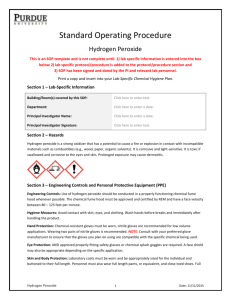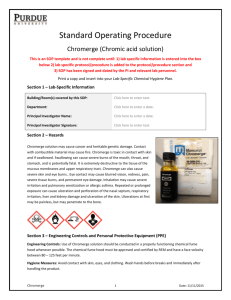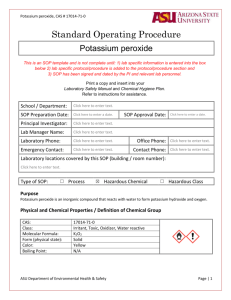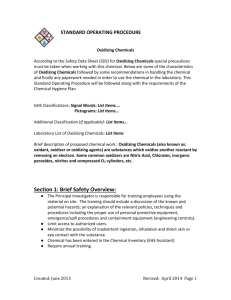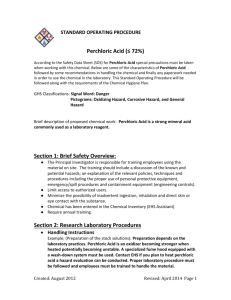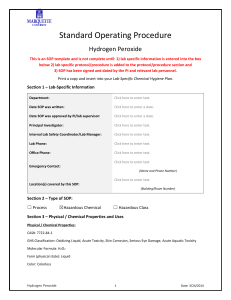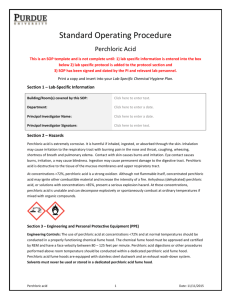Strong Oxidizing Agents SOP
advertisement
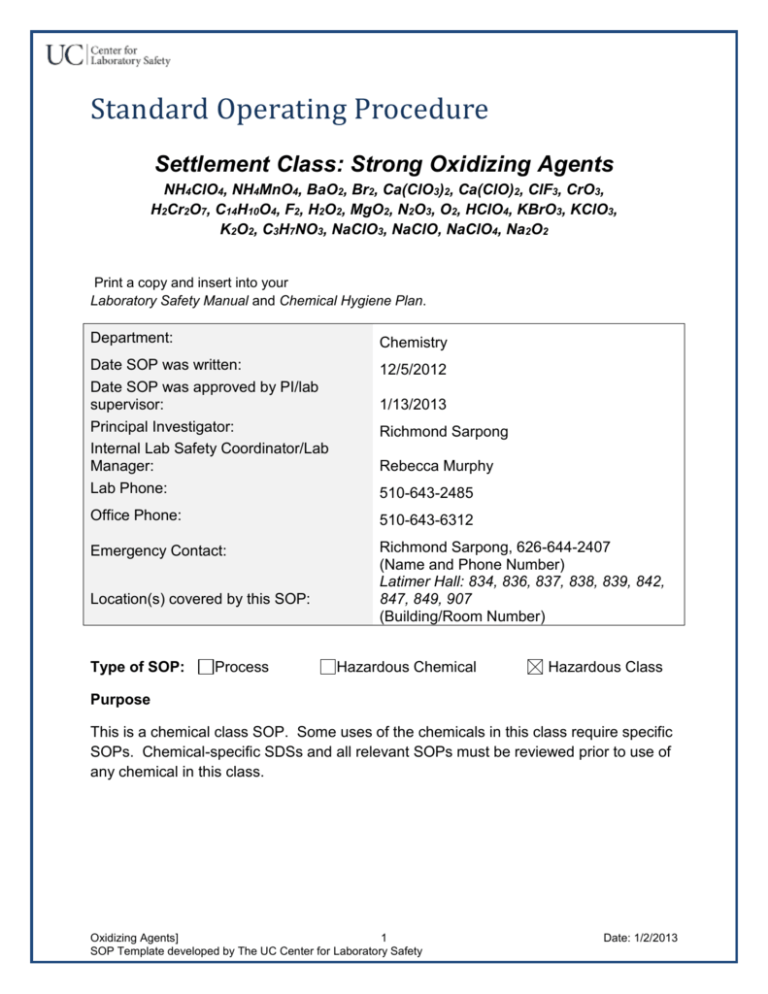
Standard Operating Procedure Settlement Class: Strong Oxidizing Agents NH4ClO4, NH4MnO4, BaO2, Br2, Ca(ClO3)2, Ca(ClO)2, ClF3, CrO3, H2Cr2O7, C14H10O4, F2, H2O2, MgO2, N2O3, O2, HClO4, KBrO3, KClO3, K2O2, C3H7NO3, NaClO3, NaClO, NaClO4, Na2O2 Print a copy and insert into your Laboratory Safety Manual and Chemical Hygiene Plan. Department: Chemistry Date SOP was written: Date SOP was approved by PI/lab supervisor: Principal Investigator: Internal Lab Safety Coordinator/Lab Manager: Lab Phone: 12/5/2012 Office Phone: 510-643-6312 Emergency Contact: Richmond Sarpong, 626-644-2407 (Name and Phone Number) Latimer Hall: 834, 836, 837, 838, 839, 842, 847, 849, 907 (Building/Room Number) Location(s) covered by this SOP: Type of SOP: Process 1/13/2013 Richmond Sarpong Rebecca Murphy 510-643-2485 Hazardous Chemical Hazardous Class Purpose This is a chemical class SOP. Some uses of the chemicals in this class require specific SOPs. Chemical-specific SDSs and all relevant SOPs must be reviewed prior to use of any chemical in this class. Oxidizing Agents] 1 SOP Template developed by The UC Center for Laboratory Safety Date: 1/2/2013 The following strong oxidizing agents are listed in the Settlement Agreement: Chemical Name Formula Ammonium perchlorate NH4ClO4 Barium peroxide BaO2 Calcium chlorate CaClO3 Chlorine trifluoride ClF3 Chromic acid H2Cr2O7 Fluorine F2 Magnesium peroxide MgO2 Oxygen O2 Potassium bromate KBrO3 Potassium peroxide K2O2 Sodium chlorate NaClO3 Sodium perchlorate NaClO4 CAS# 7790-98-9 Chemical Name/Formula Ammonium permanganate KMNO4 1304-29-6 Bromine Br2 10043-53-4 Calcium hypochlorite CaClO 7790-91-2 Chromium anhydride CrO3 1308-38-9 Dibenzoyl peroxide C14H10O4 7782-41-4 Hydrogen peroxide H2O2 1335-26-8 Nitrogen trioxide N2O3 7782-44-7 Perchloric acid HClO4 7758-01-2 Potassium chlorate KClO3 17014-71-0 Propyl nitrate C3H7NO3 7775-09-9 Sodium Chlorite NaClO 7601-89-0 Sodium peroxide Na2O2 CAS# 13446-10-1 7726-95-6 7778-54-3 1333-82-0 94-36-0 7722-84-1 10544-73-7 7601-80-3 3811-04-9 627-13-4 7758-19-2 1212-60-6 Potential Hazards/Toxicity Strong oxidizing agents generally create a hazard when combined with other materials. There are four categories of strong oxidizers, divided by the severity of risk when mixed with other compounds: 1. A material that may increase the burn rate of another material. 2. A material that will moderately increase the burn rate. 3. A material that will cause a severe increase in burn rate. 4. A material that has the potential to lead to an explosive oxidation with combined with other materials. Class 1. Generally, it is the anionic component of a salt that causes the oxidation. Examples in class 1 are metal salts of chromates and dicromates, chlorates and perchlorates, nitrates, peroxides, and perborates. Perchloric acid (below 70% conc.) and hydrogen peroxide (8-27% conc.) are prominent examples of non-salts in this class. Class 2. Salts in class two are those of hypochlorite, permanganate, and peroxide. Nonsalts in this class are chromium trioxide, hydrogen peroxide (27-52%), halane, and nitric acid (>70%). Class 3. Common class 3 oxidizers are ammonium dichromate, potassium chlorate, hydrogen peroxide (55-91%), calcium hypochlorite, sodium chlorate, perchloric acid (6072%), sodium chlorite (>40%), and potassium bromate. Oxidizing Agents] 2 SOP Template developed by The UC Center for Laboratory Safety Date: 1/2/2013 Class 4. Materials in class 4 include ammonium perchlorate, ammonium permanganate, guanidine nitrate, hydrogen peroxide (>92%), perchloric acid (>72%), and potassium superoxide. Common groups of strong oxidizing agents: Class 1: Metal salts of chromates and dicromates, chlorates and perchlorates, nitrates, peroxides, and perborates. Non-salts such as Perchloric acid (below 70% conc.) and hydrogen peroxide (8-27% conc.). Class 2: Salts of hypochlorite, permanganate, and peroxide. Non-salts such as chromium trioxide, hydrogen peroxide (27-52%), halane, and nitric acid (>70%). Class 3: Ammonium dichromate, potassium chlorate, hydrogen peroxide (55-91%), calcium hypochlorite, sodium chlorate, perchloric acid (60-72%), sodium chlorite (>40%), and potassium bromate. Class 4: Ammonium perchlorate, ammonium permanganate, guanidine nitrate, hydrogen peroxide (>92%), perchloric acid (>72%), and potassium superoxide. Personal Protective Equipment (PPE) NOTE: Lab-specific information on PPE selection may be included in the Protocol/Procedure section. Engineering Controls NOTE: Lab-specific information on engineering controls may be included in the Protocol/Procedure section. Work with strong oxidizing agents should be conducted in a fume hood unless other controls are designated in the lab-specific Protocol/Procedure section. Sash height should be kept low to avoid escaping fumes and provide a physical barrier. Perchloric acid has a notorious history of causing unanticipated explosions. Perchloric acid can form explosive salts almost anywhere, including in the exhaust ducts of fume hoods and even laboratory benches where other materials have been spilled in the past. Many perchlorate salts are shock sensitive and can lay dormant for very long periods. For these reasons, it is imperative that perchloric acid only be used is a perchloric acid designated fume hood that is not used for any other function. Spills should be immediately and thoroughly cleaned up. This fume hood shall be prominently marked as for use ONLY with perchloric acid and no other materials. EH&S should be contacted Oxidizing Agents] 3 SOP Template developed by The UC Center for Laboratory Safety Date: 1/2/2013 for proper signage and approvals. Keep in mind that only a new fume hood can be designated for perchloric acid use. Respiratory protection NOTE: Lab personnel intending to use/wear a respirator mask must be trained and fittested by EH&S. This is a regulatory requirement. Respirators should be used only under any of the following circumstances: As a last line of defense (i.e., after engineering and administrative controls have been exhausted). When Permissible Exposure Limit (PEL) has exceeded or when there is a possibility that PEL will be exceeded. Regulations require the use of a respirator. An employer requires the use of a respirator. There is potential for harmful exposure due to an atmospheric contaminant (in the absence of PEL) As PPE in the event of a chemical spill clean-up process Hand Protection Handle with gloves. Gloves must be inspected prior to use. Use proper glove removal technique (without touching glove's outer surface) to avoid skin contact with this product. Dispose of contaminated gloves after use in accordance with applicable laws and good laboratory practices. Wash and dry hands. NOTE: Lab-specific and chemical-specific information on glove selection may be included in the Protocol/Procedure section. Refer to glove selection from the link below: For glove selection, go to: http://ehs.berkeley.edu/hs/63-laboratory-safety/94-gloveselection-and-usage.html Eye Protection Tightly fitting safety goggles. Use face shield (8-inch minimum) when appropriate (not protected by fume hood sash for example). Use equipment for eye protection tested and approved under appropriate government standards such as NIOSH (US) or EN 166(EU) or ANSI Z87.1. Oxidizing Agents] 4 SOP Template developed by The UC Center for Laboratory Safety Date: 1/2/2013 Skin and Body Protection Long pants, closed-toed and closed-heeled shoes, cotton-based clothing/attire, and lab coat must be worn for protecting against chemical hazards. Hygiene Measures Handle in accordance with good industrial hygiene and safety practice. Wash hands before breaks and at the end of workday. First Aid Procedures Notify supervisor and EH&S immediately. Follow up with a call to 510-642-9090 to report the incident. If inhaled Move person into fresh air. If not breathing, give artificial respiration. Consult a physician. In case of skin contact Take off contaminated clothing immediately. Wash off with soap and plenty of water for 15 minutes. Take victim immediately to hospital. Consult a physician. In case of eye contact Rinse thoroughly with plenty of water for at least 15 minutes, occasionally lifting the upper and lower eyelids. Get medical aid immediately. If swallowed Do not induce vomiting. Never give anything by mouth to an unconscious person. Rinse mouth with water. Consult a physician. Special Handling and Storage Requirements NOTE: Lab-specific information on handling and storage may be included in the Protocol/Procedure section. Working alone Certain extremely hazardous operations should not be performed if the PI or Lab Safety Contact(s) are not present. Never work alone with extremely hazardous materials/operations. See the Protocol/Procedure section below for specific prohibitions (if any) on working alone. Precautions for safe handling Depending on the level of reactivity of the oxidizing agent, care must be taken to insure that the proper procedural requirements are in place as the agent is being used. Oxidizing Agents] 5 SOP Template developed by The UC Center for Laboratory Safety Date: 1/2/2013 Conditions for safe storage Do not store near combustible materials or other chemicals that are easily oxidized. Keep container closed when not in use. Store in a cool, dry, well-ventilated area away from incompatible substances. Store protected from moisture. Spill and Accident Procedure Chemical Spill Dial 911 Spill – Assess the extent of danger. Help contaminated or injured persons. Evacuate the spill area. Avoid breathing vapors. If possible, confine the spill to a small area using a spill kit or absorbent material. Keep others from entering contaminated area (e.g., use caution tape, barriers, etc.). Small (<1 L) – If you have training, you may assist in the clean-up effort. Use appropriate personal protective equipment and clean-up material for chemical spilled. Double bag spill waste in clear plastic bags, label and take to the next chemical waste pick-up. Large (>1 L) – Dial 911 and 510-642-9090 for assistance. Chemical Spill on Body or Clothes – Remove clothing and rinse body thoroughly in emergency shower for at least 15 minutes. Seek medical attention. Notify supervisor and EH&S immediately. Follow up with a call to 510-642-9090 to report the incident. Chemical Splash Into Eyes – Immediately rinse eyeball and inner surface of eyelid with water from the emergency eyewash station for 15 minutes by forcibly holding the eye open. Seek medical attention. Notify supervisor and EH&S immediately. Follow up with a call to 510-642-9090 to report the incident. Medical Emergency Dial 911 Life Threatening Emergency, After Hours, Weekends And Holidays – Dial 911 or go to the nearest emergency room. Note: All serious injuries must be reported to EH&S within 8 hours. Follow up with a call to 510-642-9090 to report the incident. Non-Life Threatening Emergency – Go to the Occupational Health Facility (Tang Health Center). After hours go to the nearest emergency room. Note: All serious injuries must be reported to EH&S within 8 hours. Follow up with a call to 510-642-9090 to report the incident. Needle stick/puncture exposure (as applicable to chemical handling procedure) – Wash the affected area with antiseptic soap and warm water for 15 minutes. For mucous membrane exposure, flush the affected area for 15 minutes using an eyewash Oxidizing Agents] 6 SOP Template developed by The UC Center for Laboratory Safety Date: 1/2/2013 station. Go to the Occupational Health Facility (Tang Health Center). After hours go to the nearest emergency room. Note: All needle stick/puncture exposures must be reported to EH&S within 8 hours. Follow up with a call to 510-642-9090 to report the incident. Decontamination/Waste Disposal Procedure NOTE: Lab-specific information on decontamination/waste disposal may be included in the Protocol/Procedure section. Wearing proper PPE, please decontaminate equipment and bench tops using soap and water. Please dispose of the spent reducing agents and disposables contaminated with reductants as hazardous waste. General hazardous waste disposal guidelines: Label Waste Strong oxidizing agent waste should be placed in a chemically compatible container with a sealed lid and clearly labeled. Label all containers with the label provided at http://ehs.berkeley.edu/hm/279-new-hazardous-waste-program-hwp.html. See the EH&S Fact Sheet, “Hazardous Waste Management” for general instructions on procedures for disposing of hazardous waste. Dispose of Waste Dispose of regularly generated chemical waste within 6 months Call EH&S for questions Safety Data Sheet (SDS) Location SDS can be accessed online at http://ucmsds.com Oxidizing Agents] 7 SOP Template developed by The UC Center for Laboratory Safety Date: 1/2/2013 Documentation of Training (signature of all users is required) Prior to conducting any work with strong oxidizing agents, designated personnel must provide training to his/her laboratory personnel specific to the hazards involved in working with the substance(s), work area decontamination, and emergency procedures. The Principal Investigator must provide his/her laboratory personnel with a copy of this SOP and a copy of the SDS provided by the manufacturer. I have read and understand the content of this SOP: Name Signature Initials Click here to enter text. Date Click here to enter a date. Click here to enter a date. Click here to enter a date. Click here to enter a date. Click here to enter a date. Click here to enter a date. Click here to enter a date. Click here to enter a date. Click here to enter a date. Click here to enter a date. Click here to enter a date. Click here to enter a date. Click here to enter a date. Click here to enter a date. Click here to enter a date. Click here to enter text. Click here to enter text. Click here to enter text. Click here to enter text. Click here to enter text. Click here to enter text. Click here to enter text. Click here to enter text. Click here to enter text. Click here to enter text. Click here to enter text. Click here to enter text. Click here to enter text. Click here to enter text. Oxidizing Agents Identification 8 Date: 1/2/2013

